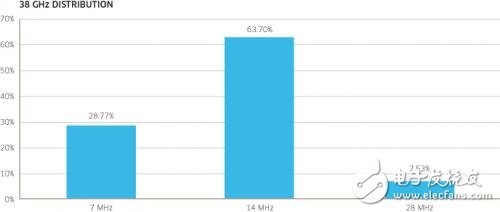As smartphones and wireless tablets that require a lot of bandwidth become more and more popular, the expansion of microwave networks becomes indispensable.
Further, operators must consider the expansion options at the wireless layer and at the packet layer. In the modern microwave network, the spectrum optimization scheme based on each link is unrealistic, and they must adopt a network-based scheme to expand the capacity. With a web-based approach, operators can:
· Avoid effective optimizations only for small scales.
· Reduce the amount of spectrum usage to help save on the cost of ownership.
Expansion principle
This paper compares two expansion methods used in modern microwave networks:
• Hierarchical Quadrature Amplitude Modulation (HQAM), which maximizes spectral efficiency by using higher order modulation in the microwave communication channel.
• The principle of packet compression, which improves spectral efficiency by reducing the overhead introduced by frame or packet structure in a fully packetized environment.
The HQAM format adds the density of modulation symbols to the transmission constellation. For example, 256-state quadrature amplitude modulation (512QAM) provides approximately 25% continuous combined gain over the available traffic capacity compared to the 1024QAM format. The 2048QAM and 4096QAM formats provide 15% additional capacity gain compared to 512QAM and 1024QAM.
Packet compression deals with the protocol overhead portion of an IP packet. Fields belonging to Ethernet, Multiprotocol Label Switching (MPLS), IP, and TCP/UDP portions are compressed prior to transmission and reconstructed at the receiving end of the microwave link. This will reduce the number of bits sent over the link, increasing the capacity of the service and application.
The effect of packet compression depends on the mix of services and conditions, making it difficult to calculate the average. However, if the IPv4-based Internet Hybrid (IMIX) service feature can increase capacity by 30% to 40%, then the IPv6-based capacity increase is at least doubled. That is to say, the expansion gain from packet compression will become more apparent when operators move from IPv4 to IPv6.
Link and network spectrum efficiency comparison
Spectral efficiency is often measured on isolated links, meaning that these links are not compromised by adjacent radio collisions and interference, and they are not themselves sources of interference. Unfortunately, interference is ubiquitous, so this approach can only provide information in the ideal link case rather than the actual network conditions.
Optimizing a single link is not an actual network design. Optimizing the network design should provide the necessary network capacity and minimal spectrum footprint for two reasons:
· Spectrum is a limited resource
· The spectrum has its corresponding use price
Therefore, using as little spectrum as possible will help operators reduce their recent network operating costs (OPEX) and preserve spectrum for future capacity growth.
Network-based capacity expansion plans focus on increasing the capacity of the entire network rather than the capacity of a single link. The decision to increase the modulation format comes from the end-to-end network design and the resulting planning of interference levels. Analysis of the level of interference means:
· Operators should carefully evaluate whether it makes sense to use high-order modulation at high-density, short-distance nodes or convergence points, and where they are most susceptible to interference damage.
· The last mile link is less affected by interference damage.
Long-haul microwave transmission is more suitable for high-order modulation formats: the number of links that make up the network is small, and the links are rarely seen in the network to aggregate to a geographic point, so the interference is less.
Real world network model
In order to better understand how high-order modulation and packet compression methods affect wireless network expansion, we analyzed a European mobile backhaul network that has 890 short-haul links and has been operated. Its largest link group - containing 146 links - operates in the 38 GHz band, which includes the last mile connection, or termination and node links. analyse as below:
· Define the theoretical maximum possible throughput of the network. This will help determine the maximum capacity supported by the network without having to involve any network elements.
· Determine network limitations before you need to redesign your network to support HSPA+ and LTE services.
· Provide a network guide for what technology or combination of technologies to use to increase network capacity.
Figure 1 shows how the 38 GHz communication band and the channel are distributed across the spectrum. This is the beginning of network analysis. According to the current spectrum utilization, the overall throughput of the microwave network is approximately 1.9 Gb/s. All links use fixed modulation to support network availability of up to 99.999%, or an annual failure time of no more than 5 minutes.

Figure 1. The 38 GHz band consists of 146 last mile connections and node links
From this point on, to analyze whether two strategies – HQAM and packet compression – can expand capacity without avoiding capital expenditures (CAPEX) and OPEX.
Led Underground Lamp is a new buried decorative light with ultra-bright LED.
As the light source and LED constant current drive as the driving mode.
Widely used in squares, outdoor parks, leisure places and other outdoor lighting, as well as park greening, lawn, square, courtyard, flower beds, pedestrian street decoration, waterfall, fountain underwater and other places night lighting, add luster to life.
Advantages of LED Underground Light with small volume, low power consumption, long service life, strong and durable, convenient installation, chic and elegant modeling, anti-leakage, waterproof.
LED Underground Light
LED Underground Light,Led Underground Lamp,Outdoor Lights,Recessed Deck Light
Jilin Province Wanhe light Co.,Ltd , https://www.wanhelight.com